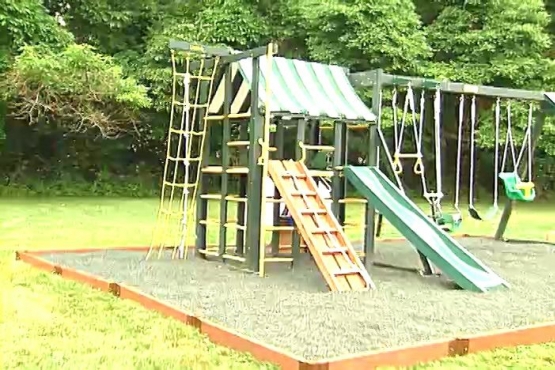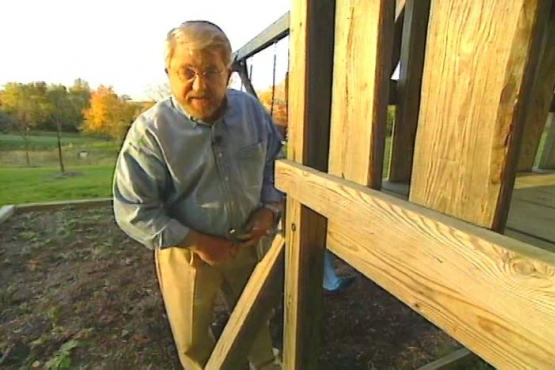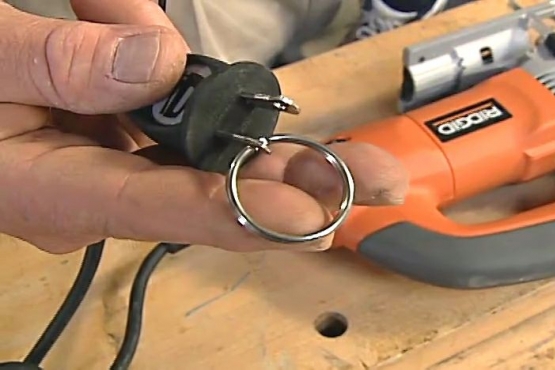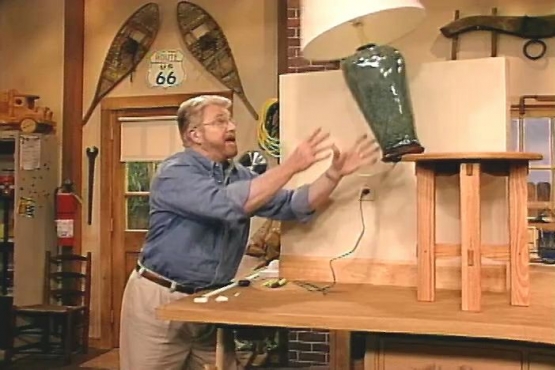RON HAZELTON:
You know my daughter is reaching that age where she's into just about everything. Actually it's great to watch her exploring and learning. But I am concerned that her curiosity might get her into trouble. So my wife Lynn and I have asked our friend Jay Marcal, a home child safety expert to drop by and do a walk through with us to make sure we haven't overlooked any potential trouble spots.
So where do you want to start? Kitchen? Bathroom?
JAY:
I think kitchen is a great idea.
LYNN:
Okay.
JAY:
It tends to be the -
[BOTH SPEAK AT ONCE]
JAY:
Hey you know guys, we walked into the kitchen. But sometimes kids come running into the kitchen.
LYNN:
Running -
[BOTH SPEAK AT ONCE]
JAY:
Right, right. And I see islands like this with a little bit of an overhang. Taking a little cushion like this. Comes in different colors. But you know what, that's not too bad.
RON HAZELTON:
The sights and smells from cook tops intrigue and attract children. Jay shows us how this barrier can offer protection.
JAY:
It's held on with adhesive and it runs along kind of like that, so it keeps splatters from coming down. Keeps pots and pans from falling off. There's a little bit of a ledge here.
RON HAZELTON:
Now like most parents, I know how important it is to keep children out of kitchen cabinets. Especially those that contain cleaning products. And while I use them, I've always found these child safety locks a bit awkward. Jay offers another possibility.
JAY:
Because even an adult can't open this latch, Ron. Go ahead, Lynn, try to open that. Make believe, make believe I installed it to your cabinets.
[BOTH SPEAK AT ONCE]
LYNN:
Jeez, Jay, I can't open it.
JAY:
Doesn't open at all. And all you have to do is reach for the magnet (that you keep out of reach, of course). Put it in the appropriate spot. It actually stays on by itself and then it can open and close.
LYNN:
I gotta tell ya, I know - I end up losing that.
JAY:
That's what people say.
LYNN:
I would end up losing that.
JAY:
Of course I tell people you can have as many magnets as you like. We could just scatter them.
LYNN:
Yeah. I think that would, I think that would drive you crazy.
RON HAZELTON:
I have seen this - this before. And I've never had them. But you're finding because when you're - I mean do you have any trouble -do you always sort of know it's about -
[BOTH SPEAK AT ONCE]
JAY:
With a loose hand, it grabs that magnet on its own.
RON HAZELTON:
Oh it does.
JAY:
It's almost automatic. And guess what, if it's driving everybody crazy and there are no kids around, you might know this feature already. By holding that in and flipping a switch, you get the activated switch -
RON HAZELTON:
This same magnetic lock can also be used in other places like our laundry chute.
JAY:
That would be a way to keep this totally closed and having the magnet out of reach. It would deactivate and you could either utilize it - you'll probably leave it locked up most of the time. These magnets are funny. It sticks on the -
[BOTH SPEAK AT ONCE]
RON HAZELTON:
Corner bay there.
JAY:
Corner bay, right. If you wanted to, you could put it as high as you want. Well I'm gonna show you how we create an entire buffer zone between the fire and your child. These 3 prongs will click into these 3 holes.
RON HAZELTON:
So, this is removable.
JAY:
And it locks in. It's removable.
LYNN:
It really - it doesn't look so bad.
RON HAZELTON:
No, I agree. And the fact that if you're gonna have a party here and there aren't gonna be kids around, you can just take it out completely, I like that very much.
LYNN:
Jay also pointed out a few things we didn't realize were hazards in the first place.
JAY:
So every once in a while I catch a big air intake vent in the floor. Sometimes they're in the wall, sometimes they're in the ceiling. But they get their fingers in here. They pull straight up and a lot of these vents are just - they're just swimming in there.
What we have is a hole that leads to your heating or cooling system. We have sharp sheet metal. We have the ends of screws and it's not usually the cleanest place in the house. Solution? Every once in a while I'm predrilling a hole, usually catty corner.
And we'll just screw it down to the wood floor. If anybody wants to clean -
[BOTH SPEAK AT ONCE]
LYNN:
That's smart, simple and smart.
JAY:
Yeah. If you want your ductwork cleaned, back out a couple of screws -
LYNN:
I never would have thought about that.
RON HAZELTON:
And would you believe it? Doorstops actually can present a choking hazard.
JAY:
This is down in the baby's domain. You know they talk about crawling around and seeing what the dangers are. And this little rubber tip can come off.
[BOTH SPEAK AT ONCE]
RON HAZELTON:
I never - I absolutely would have -
[BOTH SPEAK AT ONCE]
LYNN:
Isn't that, yeah, I never would have thought. And this is the kind of thing Danielle definitely would put in her mouth.
JAY:
Everything goes in the mouth at this age. That's right. We just unscrewed the original doorstop. And we screwed in a replacement doorstop that has a flexible tip.
LYNN:
That’s good.
JAY:
And we'll get the same job done.
RON HAZELTON:
And it’s one solid piece.
JAY:
But nothing to come off. Just sliding out of the covers, which snap back.
[BOTH SPEAK AT ONCE]
LYNN:
Those I like.
JAY:
This goes over the outlets. And then if something was plugged in. See kids want to pull out plugs and out plugs and push them in. They want to do things in repetition. Their finger might be touching the metal when they go to push it in and out.
So if they pull this out, it just slides closed. End of story. Stairs and gates. Our goal: have a properly mounted stair gate at the top of the stairs that's easy for you to work and safe for the baby. This is one of our favorite gates for the top of the stairs.
It is metal -
RON HAZELTON:
Well for me, child gates must protect kids but not confound the adults who have to use them. To put up gates on irregular surfaces, Jay first mounts a wood strip, then attaches the hardware to it. This technique works well even on stair railing posts.
Very nice, Jay. Yeah, you see, I was looking at this, all these irregular surfaces. I was going through all kinds of things blocking out. This is very simple. It - it looks nice.
JAY:
So this is the latch. You lift the gate slightly and it comes out of its cradle.
RON HAZELTON:
Oh I see. So it can't go - it can't go any further this way -
[BOTH SPEAK AT ONCE]
JAY:
It can't go this way. It has little stops.
RON HAZELTON:
So that's the general rule. Any gate at the top of the stairs wants to open away from the stairs.
JAY:
If possible, yes.
RON HAZELTON:
Well, Jay's put the gate in for me. But he's left me with quite a few things to do on my own. Gotta install cabinet locks, put up a cook top shield, screw down our vent grilles, add sliding receptacle covers and replace our doorstops.
Yep, a fair amount of work. But I'll happily do all of it and a whole lot more to keep this little gal safe. Maria Montessori, the founder of the Montessori method of education, once said never help a child with a task at which he feels he can succeed. That approach obviously helps a youngster develop confidence and independence.
It certainly worked for me. That's why I never have to ask for driving directions.









